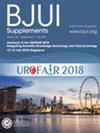Pain location after ureteroscopy differs based on sex and stone location: results from STENTS.
IF 3.7
2区 医学
Q1 UROLOGY & NEPHROLOGY
引用次数: 0
Abstract
OBJECTIVES To expand understanding of the patient experience after ureteroscopy with stent placement for ureteric and/or renal stones using a body map to identify pain location and site-specific pain intensity over time, while evaluating the associations of sex and stone location. PATIENTS AND METHODS Participants in a multicentre prospective observational cohort study completed questionnaires at baseline and on postoperative days (PODs) 1, 3 and 5. Pain distribution and intensity were assessed using the Brief Pain Inventory body and genitalia maps, with results stratified by sex and stone location. RESULTS A total of 424 participants (47% female, mean age 49 years) at four centres were included. The most frequent sites of stent-associated pain were the back, followed by the abdomen and pubic regions. Male participants were more likely to report the ipsilateral back as the site with most intense pain on POD 1 (43% vs 19%; P < 0.01) and POD 3 (43% vs 24%; P < 0.01), independent of stone location; they also reported more burning during urination on all PODs (P < 0.01). Female participants more often reported pain in the abdomen on POD 1 (67% vs 50%; P = 0.01) and in the pubic region on POD 3 (56% vs 37%; P < 0.01). Genital pain was common and peaked on POD 1 in both sexes. Participants with a renal stone were more likely to report back pain (70% vs 53%; P = 0.009) and a higher pain intensity score in the back (P = 0.014) on POD 1. Participants with ureteric stones were more likely to have baseline abdominal pain, most intense pain in the pubic region (27% vs 14%; P = 0.017), and burning during urination on POD 1 (P < 0.001). CONCLUSIONS Body pain map analysis provides new insights into patient experiences after ureteroscopy, with significant differences in pain location and intensity based on sex and stone location. These results can inform patient-specific counselling in the preoperative setting, contribute to a better understanding of the patient experience, and help tailor management decisions.输尿管镜检查后疼痛位置因性别和结石位置不同而不同:来自支架的结果。
目的:扩大对输尿管镜下输尿管和/或肾结石支架置入术后患者体验的理解,使用身体图识别疼痛部位和部位特异性疼痛强度随时间的变化,同时评估性别和结石位置的关系。患者和方法在一项多中心前瞻性观察队列研究中,参与者在基线和术后第1、3和5天完成问卷调查。疼痛分布和强度评估使用简短疼痛量表身体和生殖器地图,结果按性别和结石位置分层。结果共纳入4个中心的424名参与者(47%为女性,平均年龄49岁)。支架相关疼痛最常见的部位是背部,其次是腹部和阴部。男性参与者更有可能报告同侧背部是POD 1中疼痛最剧烈的部位(43%对19%;P < 0.01)和POD 3 (43% vs 24%;P < 0.01),与石位无关;所有pod患者排尿时有更多灼烧感(P < 0.01)。女性受试者在POD 1时更常报告腹部疼痛(67% vs 50%;P = 0.01)和耻骨区POD 3 (56% vs 37%;p < 0.01)。生殖器疼痛是常见的,并在POD 1在两性中达到高峰。患有肾结石的参与者更有可能报告背痛(70% vs 53%;P = 0.009), POD 1时背部疼痛强度评分较高(P = 0.014)。输尿管结石的参与者更有可能出现基线腹痛,耻骨区域最剧烈的疼痛(27% vs 14%;P = 0.017), POD 1排尿时灼烧(P < 0.001)。结论身体疼痛图分析为输尿管镜术后患者体验提供了新的见解,不同性别和结石位置的患者在疼痛部位和强度上存在显著差异。这些结果可以为术前患者的具体咨询提供信息,有助于更好地了解患者的经历,并有助于制定管理决策。
本文章由计算机程序翻译,如有差异,请以英文原文为准。
求助全文
约1分钟内获得全文
求助全文
来源期刊

BJU International
医学-泌尿学与肾脏学
CiteScore
9.10
自引率
4.40%
发文量
262
审稿时长
1 months
期刊介绍:
BJUI is one of the most highly respected medical journals in the world, with a truly international range of published papers and appeal. Every issue gives invaluable practical information in the form of original articles, reviews, comments, surgical education articles, and translational science articles in the field of urology. BJUI employs topical sections, and is in full colour, making it easier to browse or search for something specific.
 求助内容:
求助内容: 应助结果提醒方式:
应助结果提醒方式:


